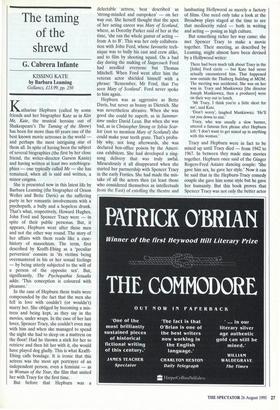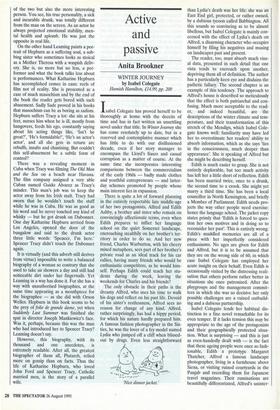The taming of the shrewd
G. Cabrera Infante
KISSING KATE by Barbara Learning
Gollancz, £13.99, pp. 250
Katharine Hepburn (called by some friends and her biographer Kate as in Kiss Me, Kate, the musical heroine out of Shakespeare's The Taming of the Shrew) has been for more than 60 years one of the best known movie actresses in the world — and perhaps the most intriguing star of them all. In spite of having been the subject of several biographies (the first by her close friend, the writer-director Garson ICanin) and having written at least two autobiogra- phies — one typically called Me — she has remained, when all is said and written, a minor enigma.
She is presented now in this latest life by Barbara Leaming (the biographer of Orson Welles and Bette Davis) as the suffering party in her romantic involvements with a psychopath, a bully and a hopeless drunk. That's what, respectively, Howard Hughes, John Ford and Spencer Tracy were — in spite of their public personas. But, it appears, Hepburn went after these men and not the other way round. The story of her affairs with them reads like a case- history of masochism. The term, first described by Krafft-Ebing as a 'peculiar perversion' consists in 'its victims being overmastered in his or her sexual feelings — by being utterly subjected to the will of a person of the opposite sex'. But, significantly, The Psychopathia Sexualis adds: 'This conception is coloured with pleasure.'
In the case of Hepburn these traits were compounded by the fact that the men she fell in love with couldn't (or wouldn't) marry her. She obliged by becoming a mis- tress and being kept, as they say in the movies, under wraps. In the case of her last lover, Spencer Tracy, she couldn't even stay with him and when she managed to spend the night she had to sleep on a mattress on the floor! Had he thrown a stick for her to retrieve and then hit her with it, she would have played dog gladly. This is what Krafft- Ebing calls bondage. It is ironic that this actress was the most apt portrayer of an independent person, even a feminist — as in Woman of the Year, the film that united her with Tracy for the first time.
But before that Hepburn was a delectable actress, best described as 'strong-minded and outspoken' — on her way out. She herself thought that the apex of her acting career was Mary of Scotland, where, as Dorothy Parker said of her at the time, 'she ran the whole gamut of acting — from A to B'. This was her only collabora- tion with John Ford, whose favourite tech- nique was to bully his cast and crew alike, and to film by shooting squad. On a bad day during the making of Stagecoach Ford had needled everyone but Thomas Mitchell. When Ford went after him the veteran actor shielded himself with a phrase: 'Remember, Mr Ford, that I've seen Mary of Scotland'. Ford never spoke to him again.
Hepburn was as aggressive as Bette Davis, but never as brassy as Dietrich. She was nevertheless abrasive. When she was good she could be superb, as in Summer- time under David Lean. But when she was bad, as in Christopher Strong or Sylvia Scar- lett (not to mention Mary of Scotland) she could make your teeth grate. That's proba- bly why, not long afterwards, she was declared box-office poison by the Ameri- can exhibitors. She had developed a sing- song delivery that was truly awful. Miraculously it all disappeared when she started her partnership with Spencer Tracy in the early Forties. She had made the mis- take of all the actors then (at least those who considered themselves as intellectuals from the East) of extolling the theatre and lambasting Hollywood as merely a factory of films. One need only take a look at the Broadway plays staged at the time to see that mediocrity ruled — both in writing and acting — posing as high culture.
But something richer her way came: she met Spencer Tracy to make a movie together. Their meeting, as described by Learning, might almost have been devised by a Hollywood writer:
There had been much talk about Tracy in the [John] Ford circle — but Kate had never actually encountered him. That happened now outside the Thalberg Building at MGM. The meeting was accidental. She was on her way in. Tracy and Mankiewicz [the director Joseph Mankiewicz, then a producer] were on their way out to lunch.
`Mr Tracy, I think you're a little short for me', said Kate.
`Don't worry', laughed Mankiewicz. `He'll cut you down to size.'
Tracy, who was usually a slow burner, uttered a famous first phrase after Hepburn left: `I don't want to get mixed up in anything with this woman.'
Tracy and Hepburn were in fact to be mixed up until Tracy died — from 1942 to 1967. In between they made nine movies together. Hepburn once said of the Ginger Rogers-Fred Astaire dancing couple: 'She gave him sex, he gave her style.' Now it can be said that in the Hepburn-Tracy comedy couple she gave him some style but he gave her humanity. But this book proves that Spencer Tracy was not only the better actor of the two but also the more interesting person. You see, his true personality, a sick and incurable drunk, was totally different from the man on the screen. As an actor he always projected emotional stability, men- tal health and aplomb. He was just the opposite in real life.
On the other hand Learning paints a por- trait of Hepburn as a suffering soul, a sob- bing sister who sometimes looks as stoical as a Mother Theresa with a waspish deliv- ery. She is, no more but no less, a per- former and what the book talks less about is performances. What Katharine Hepburn has accomplished comes in cans: reels of film not of reality. She is presented as a case of much masochism and by the end of the book the reader gets bored with such abasement. Sadly Sade proved in his books that masochism can be as boring as sadism. Hepburn suffers Tracy a lot: she sits at his feet, nurses him when he is ill, mostly from hangovers, feeds his ego, constantly saying about his acting things like, 'Isn't he great?', 'He's formidable!', 'He's an actor's actor', and all she gets in return are rebuffs, insults and chastising. But couldn't this self-abasement be a subtle form of control?
There was a revealing moment in Cuba when Tracy was filming The Old Man and the Sea on a beach near Havana. The film company assigned a very able Cuban named Guido Alvarez as Tracy's minder. This man's job was to keep the actor away from his Irish malt. Tracy had sworn that he wouldn't touch the stuff while he was in Cuba. He was as good as his word and he never touched any kind of whisky — but he got drunk on Dubonnet. One day Katharine Hepburn arrived from Los Angeles, opened the door of the bungalow and said to the drunk actor three little words: 'Spencer, I'm here.' Spencer Tracy didn't touch the Dubonnet again.
It is virtually (and this adverb still derives from virtue) impossible to write a balanced biography of a woman so contrary that she used to take six showers a day and still had noticeable dirt under her fingernails. Yet Learning in a way has done it. For she has a way with unauthorised biographies, at the same time appearing as a mouthpiece for the biographee — as she did with Orson Welles. Hepburn in this book seems to be the prey of folie de grande dame, yet when Suddenly Last Summer was finished she spat in director Joseph Mankiewicz's face. Was it, perhaps, because this was the man who had introduced her to Spencer Tracy? Learning doesn't say.
However, this biography, with its thousand and one anecdotes, is extremely readable. After all, the greatest biographer of them all, Plutarch, relied more on gossip than on facts. Thus the life of Katharine Hepburn, who loved John Ford and Spencer Tracy, Catholic married men, is the story of a parallel wife.



















































 Previous page
Previous page